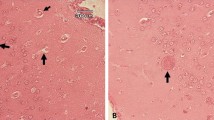Abstract
In the present study, a total of 14 (73.68%) cases of abortions and two (100%) cases of still births were detected positive for Trypanosoma evansi infection by wet and dry blood smear examination and fetal tissue PCR in camels of an organized farm. The abortions in infected dams were recorded from 8 to 11.5 month of gestation, however majority occurred during 9th to 10th month. The important laboratorial findings in infected dams were anemia, hypoglycemia, hyperproteinemia and leukocytosis. At necropsy the T. evansi infected aborted and still born fetuses showed subcutaneous edema, presence of moderate amount of dark red hemolysed blood in thoracic and abdominal cavity, bronchopneumonia, hepatic necrosis and acute congestion in all vital organs. Microscopically, there was severe congestion, thickening of bronchial and alveolar wall and mononuclear infiltration in the fetal lung, necrotic and degenerative changes in the liver, nephritis along with severe congestion and tubular necrosis in the kidneys and necrotic and degenerative changes and congestion of capillaries in the brain. The T. evansi DNA was detected by PCR from blood, lung, spleen, liver, kidney and brain of all the infected aborted and still born fetuses. The results of the study indicated that T. evansi can cross placental barrier and cause pathological events in the fetus resulting into abortion or still birth in pregnant camels.
Similar content being viewed by others
References
Arunasalam V., Chandrawathani P., Sivanandan S. 1995. An outbreak of Trypansoma evansi infection in pigs. Journal Veterinary Malaysia, 7, 71–73
Boid R., Jones T.W., Luckins A.G. 1986. Protozoal diseases of camels. In: (Ed. A. Higgins) The camel in health and disease. Baillière Tindall, London, pp. 41–59
Bricker B., Halling S. 1994. Differentiation of Brucella abortus bv 1, 2 and 4, Brucella melitensis, Brucella ovis and Brucella suis bv 1 by PCR. Journal of Clinical Microbiology, 32, 2660–2666
Desquesnes M., Dargantes A., Lai D.H., Lun Z.R., Holzmuller P., Jittapalapong S. 2013. Trypanosoma evansi and Surra: a review and perspectives on transmission, epidemiology and control, impact, and zoonotic aspects. BioMed Research International, 2013, Article ID 321237, 20 pages. DOI: 10.1155/2013/321237
Dioli M., Stimmelmayr R. 1992. Important camel diseases. In: (Eds. H.J. Schwartz and M. Dioli) The one-humped camel (Camelus dromedarius) in Eastern Africa. A pictorial guide to diseases, health care and management. Verlag Josef Margraf, Weikersheim, Germany, pp. 155–224
Elhaig M.M., Youssef A.I., El-Gayar A.K. 2013. Molecular and parasitological detection of Trypanosoma evansi in camels in Ismailia, Egypt. Veterinary Parasitololgy, 198, 214–218. DOI: 10.1016/j.vetpar.2013.08.003
Enwezor F.N.C., Sackey A.K.B. 2005. Camel trypanosomosis- a review. Veterinarski Arhiv, 75, 439–452
Gutierrez C., Corbera J.A., Juste M.C., Doreste F., Morales I. 2005. An outbreak of abortions and high neonatal mortality associated with Trypanosoma evansi infection in dromedary camels in the Canary Islands. Veterinary Parasitology, 130, 163–168. DOI:10.1016/j.vetpar.2005.02.009
Gutierrez C., Tamarit A., Gonzalez-Martin M., Tejedor-Junco M.T. 2014. Control and eventual eradication of Trypanosoma evansi infection in dromedary camels after an episodic outbreak in mainland Spain: An example in a non-endemic area. Veterinary Parasitology, 204, 153–157. DOI: 10.1016/j.vetpar.2014.05.004
Jain N.C. 1986. Schalm’s Veterinary Hematology, 4th ed. Lea & Febiger, Philadelphia, 589–626
Jittapalapong S., Pinyopanuwat N., Inpankaew T., Sangvaranond A., Phasuk C., Chimnoi W., Kengradomkij C., Kamyingkird K., Sarataphan N., Desquesnes M., Arunvipas P., 2009. Prevalence of Trypanosoma evansi infection causing abortion in dairy cows in central Thailand. Kasetsart Journal, 43, 53–57
Kumar R., Kumar S., Virmani N., Yadav S.C., 2015. Transplacental transmission of Trypanosoma evansi from experimentally infected donkey mare to neonatal foal. Journal of Equine Veterinary Science, 35, 337–341. DOI: 10.1016/j.jevs.2015.02.004
Leigh O.O., Fayemi O.E. 2013. The effects of experimental Trypanosoma brucei infection on hormonal changes during the oestrous cycle, pregnancy and pregnancy outcome in West African dwarf goat does. Wayamba Journal of Animal Sciences, 2013, 685–695
Lohr K.F., Pholpark S., Siriwan P., Leesirikul N., Srikitjakarn G., Staak C. 1986. Trypanosoma evansi infection in buffaloes in north-east Thailand II. Abortions. Tropical Animal Health and Production, 18, 103–108. DOI:10.1007/BF02359721
Ohaeri C.C., Eluwa M.C. 2011. Abnormal biochemical and haematological indices in trypanosomiasis as a threat to herd production. Veterinary Parasitology, 177, 199–202. DOI: 10.1016/j.vetpar.2011.02.002
Padmaja K. 2012. Haemato-biochemical studies of camels infested with trypanosomiasis. Veterinary World, 5, 356–358. DOI: 10.5455/vetworld.2012.356-358
Silva R.A.M.S., Arosemena N.A.E., Herrera H.M., Sahib C.A., Ferreira M.S.J. 1995. Outbreak of trypanosomosis due to Trypanosoma evansi in horses of Pantanal Mato-grossense, Brazil. Veterinary Parasitology, 60, 167–171. DOI: 10.1016/0304-4017(94)00757-4
Silva T.M.F., Olinda R. G., Rodrigues C.M.F., Camara A.C.L., Lopes F.C., Coelho W.A.C., Ribeiro M.F.B., Freitas C.I.A., Teixeira M.M.G., Batista J.S. 2013. Pathogenesis of reproductive failure induced by Trypanosoma vivax in experimentally infected pregnant ewes. Veterinary Research, 44, 1. DOI:10.1186/1297-9716-44-1
Singh N., Pathak K.M., Kumar R., 2004. A comparative evaluation of parasitological, serological and DNA amplification methods for diagnosis of natural Trypanosoma evansi infection in camels. Veterinary Parasitology, 126, 365–373. DOI:10.1016/j.vetpar.2004.08.013
Tibary A., Fite C., Anouassi A., Sghiri A., 2006. Infectious causes of reproductive loss in camelids. Theriogenology, 66, 633–647. DOI:10.1016/j.theriogenology.2006.04.008.
Wuyts N., Chodesajjawatee N., Panyim, S. 1994. A simplified and highly sensitive detection of Trypanosoma evansi by DNA amplification. Southeast Asian Journal of Tropical Medicine. Public Health, 25, 266–271
Yagil R. 1982. FAO Animal Production and Health Paper No. 26. Camels and Camel Milk. Food and Agriculture Organization of the United Nations, Rome, pp. 41
Author information
Authors and Affiliations
Corresponding author
Rights and permissions
About this article
Cite this article
Narnaware, S.D., Ghorui, S.K., Kumar, S. et al. Vertical transmission of Trypanosoma evansi in dromedary camels and studies on fetal pathology, diagnosis and treatment. Acta Parasit. 61, 329–336 (2016). https://doi.org/10.1515/ap-2016-0043
Received:
Revised:
Accepted:
Published:
Issue Date:
DOI: https://doi.org/10.1515/ap-2016-0043




